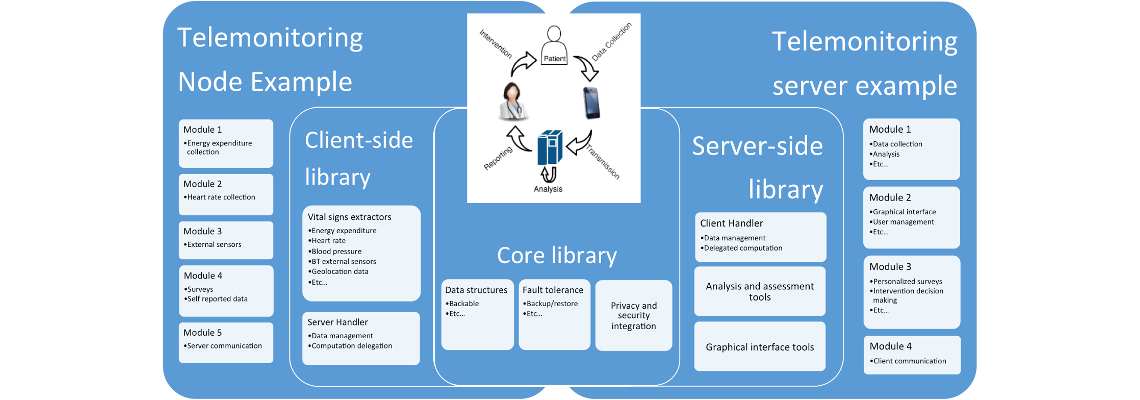
Above: Telemonitoring project infrastructure.

Within the current healthcare system, healthcare providers are largely reliant on discrete, in-person visits to monitor patients’ health. Real-time telemonitoring of a person’s well-being through wearable sensors and other electronic accessories therefore holds promise to provide better quality care, as it offers providers continuous data.
The design and implementation of telemonitoring applications, however, is a cumbersome process that requires a high level of experience in software development, especially smartphone app development — a skill few healthcare providers possess. Our team is working to develop a general-purpose telemonitoring framework that can be used to easily implement telemonitoring applications on Android devices.
Our framework incorporates fault tolerance, privacy, security, storage, and communication mechanisms in a set of libraries that can be used by the system designers to implement telemonitoring technologies. Additionally, the framework provides an easy-to-use Bluetooth stack, which allows telemonitoring applications to easily integrate Bluetooth-enabled health devices without the burden of implementing low-level protocols. The framework also supports estimating vital signs from internal phone sensors and allows simple integration of surveys in any telemonitoring application.
More information is available on the project website.
Recently, attention to privacy has been rising in the healthcare industry, with the spread of electronic health records and the growing necessity of data sharing between medical institutions. Traditional encryption approaches to maintaining privacy often assume that the transmitted data is the atomic private object. In more general scenarios, however, the data can be used to infer private information about the subjects. For example, respiration rate by itself might not be considered private information. However, if the data from the collected respiration rate is used to infer whether the individual is a smoker or not, it becomes sensitive information.
Under such circumstances, one should attempt to privatize the data in a way that reveals as little as possible about individuals’ private information to unintended recipients. The HART Lab’s Private Disclosure of Information (PDI) framework tackles this problem by preventing an adversary from inferring certain sensitive information about the subject using the data that was disclosed during communication with an intended recipient. PDI is an information-theoretic, statistical framework that introduces a view that considers the interpretation of data, through inference, in maintaining privacy.
In the PDI framework, each subject belongs to a private class (such as a health condition or a disease). The subject-class membership can be statistically inferred from the data that the subject discloses during communication (data such as vital signs, symptoms, sensory data, etc.). PDI considers cases, such as telemonitoring, where this class membership is known to both the subject themself and to the intended recipient, but not to a passive, man-in-the-middle adversary. PDI leverages this advantage in knowledge in order to minimize the amount of information leaked by the communication to an adversary that is trying to infer the class membership of subjects from the communicated data.
Daniel Aranki, Gregorij Kurillo, and Ruzena Bajcsy. Smartphone Based Real-Time Health Monitoring and Intervention. Handbook of Large-Scale Distributed Computing in Smart Healthcare, pages 473-514. Springer, 2017.
Daniel Aranki, Uma Balakrishnan, Hannah Sarver, Lucas Serven, Carlos Asuncion, Kaidi Du, Caitlin Gruis, Gao Xian Peh, Yu Xiao and Ruzena Bajcsy. RunningCoach – Cadence Training System for Long-Distance Runners. In EAI International Conference on Pervasive Computing Technologies for Healthcare (PervasiveHealth). EAI, 2017.
Daniel Aranki, Gregorij Kurillo, Adarsh Mani, Phillip Azar, Jochem Van Gaalen, Quan Peng, Priyanka Nigam, Maya P Reddy, Sneha Sankavaram, Qiyin Wu, et al. A telemonitoring framework for android devices. In IEEE International Conference on Connected Health: Applications, Systems and Engineering Technologies (CHASE), pages 282–291. IEEE, 2016.
Uma Balakrishnan, Carlos Asuncion, Hannah Sarver, Lucas Serven, Eugene Song, Ruzena Bajcsy, Daniel Aranki, and Ali Javey. A telemonitoring solution to long-distance running coaching. 2016.
Daniel Aranki, Gregorij Kurillo, Posu Yan, David M Liebovitz, and Ruzena Bajcsy. Real-time tele-monitoring of patients with chronic heart-failure using a smartphone: Lessons learned. 2016.
Daniel Aranki and Ruzena Bajcsy. Private disclosure of information in health tele-monitoring. arXiv preprint arXiv:1504.07313, 2015.
Daniel Aranki, Gregorij Kurillo, Posu Yan, David M Liebovitz, and Ruzena Bajcsy. Continuous, real-time tele-monitoring of patients with chronic heart-failure: Lessons learned from a pilot study. In Proceedings of the 9th International Conference on Body Area Networks, pages 135–141. ICST (Institute for Computer Sciences, Social-Informatics and Telecommunications Engineering), 2014.